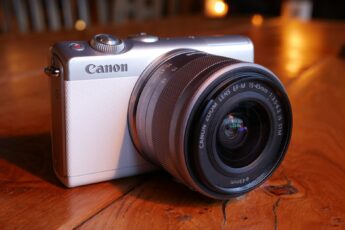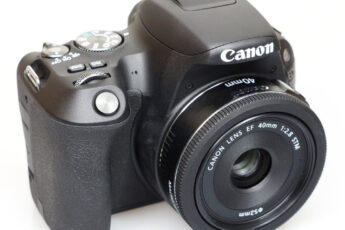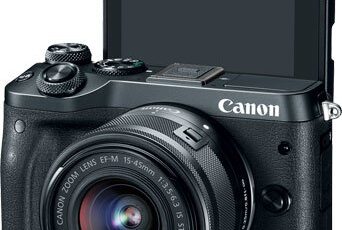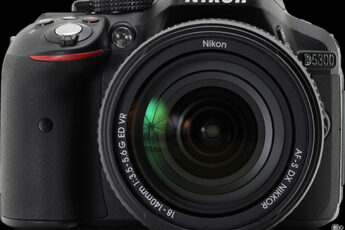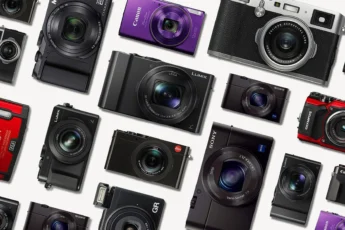Are you ready to buy this camera?
- Technical Specifications
- Build Quality
- Image Quality
- What additional features does the Canon EOS Rebel T6 have?
- Mode Dial Functions
- Feature Guide
- Flexible LCD display
- Other Features
- How does the Canon EOS Rebel T6 compare to the Nikon D3400?
- Advantages of the Canon EOS Rebel T6
- Advantages of the Nikon D3400
- How does the Canon EOS Rebel T6 compare to the Canon EOS Rebel T6i?
- Who should buy the Canon EOS Rebel T6?
- Sample Images
- Conclusion
Technical Specifications
- Price: from $549.00
- Kit Lens: EF-S 18-55mm f/3.5-5.6 IS II. “EF-S” describes the lens mount of the camera. And “IS II” means this is a second generation lens design with Image Stabilization.
- Sensor: 18 MP sensor (APS-C sized 22.3 x 14.9 mm)
- Number of Autofocus Points: 9 Phase Detection Autofocus points. Phase detection uses paired AF sensors that analyze light received from the subject. If the light is different between the pairs, the camera knows the focus is off and adjusts.
- Built-In Flash: Yes with 9.2 m (30.2 foot) range at ISO 100. The flash detection range increases as you increase light sensitivity.
- Continuous Shooting: 3 frames per second
- ISO Range: 100-6,400, with a digital ISO boost to 12,800. Digital ISO boosts artificially increase the maximum ISO range but also create extra image noise.
- Video Recording Capability: Full HD 1920×1080 (30, 24 fps), HD 1280×720 (60 fps), SD 640×480 (30 fps)
- Image Format: JPEG and RAW. The image format most commonly encountered is JPEG. As a compressed format, JPEGs take up less space in the memory of a device. But they also have reduced image quality. RAW files are uncompressed, which makes them much larger than JPEGs. Because they contain all the original image data from the camera, RAW is the best file format for editing.
- Wireless Connectivity: Wi-Fi and NFC (Near Field Connectivity) enabled. With the Canon Camera Connect app, users can remote control the T6 using a compatible smart device. Users can also send photos from the Rebel T6 directly to the smart device.
- Supported Memory Cards: SD, SDHC, SDXC
- Battery Life (CIPA Rating): 500 images per charge
- Weight: 485 g (1.07 lb / 17.11 oz)
- Dimensions: 129 x 101 x 78 mm (5.08 x 3.98 x 3.07 in)
Build Quality
The plastic body is lightweight, yet has the bulky design DSLR users are accustomed to. Because the T6 is a beginner model, the size compared to point-and-shoot cameras may take some getting used to. It’s lightweight and not too much of a burden with the included neck strap. But the size ensures it can’t be so be easily stowed and forgotten if you decide to take a break from shooting. With a single Mode and Exposure Control dial, the T6 is meant to be as streamlined and efficient as possible. The Live View, menu selection, and other major functions are all clearly laid out with dedicated buttons. Like all cameras in the Rebel series, the T6 has a thick, leather textured handgrip that feels secure to hold one-handed. The 920,000 pixel LCD screen flips up and down but is not fully articulating.
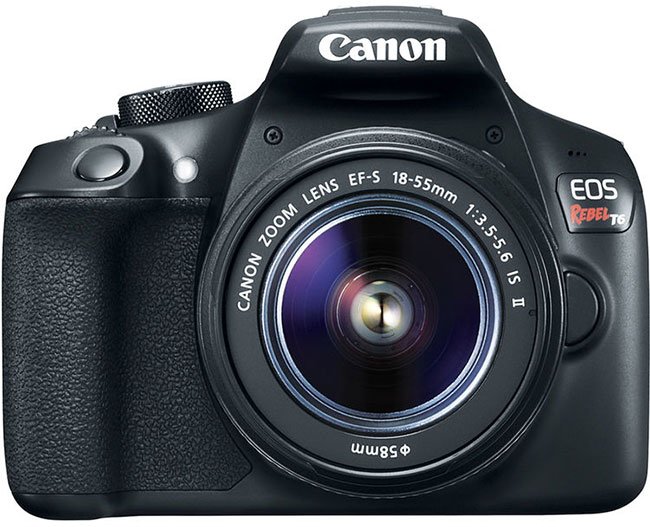
Image Quality
With 18 megapixels of resolution, the Rebel T6 has slightly less than the 20-24 MP that’s standard in today’s DSLR market. But megapixel counts are not as important as manufacturers would have you believe. Megapixels are a count of how many pixels the image sensor contains. And it relates directly to how much detail the resulting photo can create.
Most DSLR cameras at this price bracket use APS-C sized sensors. Canon’s are sized at 22.3 x 14.9 mm while other brands may be a millimeter or two larger or smaller. While other models and brands may have more megapixels, the area of the sensor is unchanged. Therefore, the pixel size has to decrease. And smaller pixels don’t gather as much light, which means they are somewhat “inferior” in quality. They have a greater chance of causing interference with each other and are more prone to noise issues. 18 MP is an excellent balance between pixel count and quality. And it allows for prints up to 11″ x 17″ in size at 300 pixels per inch.
Sensor size also determines depth of field control. Depth of field is how much of a scene to be photographed is in sharp focus. Full-frame sensors (sized 36 x 24 mm) give the best depth of field control thanks to their large sensor surface area. But APS-C sensors are the next best thing, and the Rebel T6 won’t disappoint so long as your lens can open wide enough using the aperture setting.
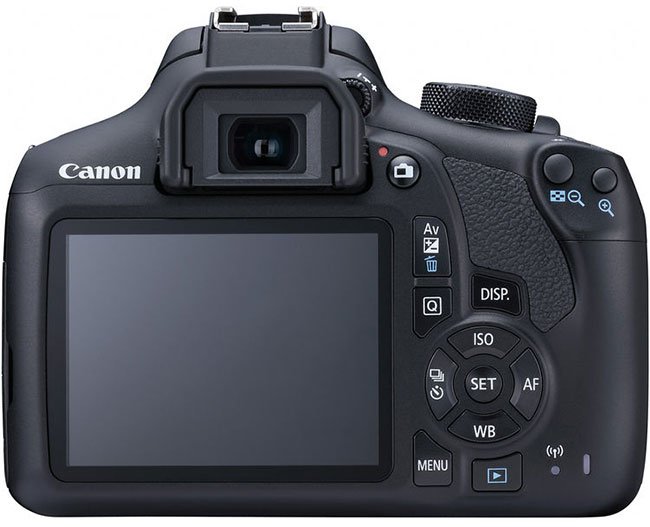
What additional features does the Canon EOS Rebel T6 have?
Mode Dial Functions
The Mode dial has several functions that may not be immediately intuitive for a new DSLR user. In what Canon calls the Basic Zone, the user choices include Scene Intelligent Auto, Flash OFF, Creative Auto, and the Image Zone (Portrait, Landscape, Close-up, Sports, Food, and Night Portrait). Scene Intelligent Auto is the same as the Auto mode for most DSLR cameras. Flash OFF is Auto Mode without the flash. The Image Zone options are designed to use the best automatic settings for particular scenes. But Creative Auto mode is the most interesting of them all. This mode simplifies photo composition for beginner DSLR users by letting them choose camera settings based on the effect they wish to create. For example, the user can select “Blur/Sharpen the background” to control aperture. This creates a sliding bar which is more intuitive than using Av or M mode and needing to know f-numbers.
The last four options are in the Creative Zone, which gives more flexibility and control for photographers who need it. These are P (Program AE), Tv (Shutter Priority), Av (Aperture Priority), and M (Manual) shooting. Program AE is a smarter Automatic mode that’s useful for the beginner DSLR user. It attempts to maintain proper exposure by adjusting your shutter speed when you change your aperture. And vice versa if you decide to adjust your aperture setting. Aperture controls the lighting exposure by increasing or decreasing the size of the hole created within the lens. And having the camera take partial control while still ensuring the exposure levels are good, is handy in many situations. Tv, Av, and M all give the photographer even greater control over the camera’s settings. Users looking to move beyond the Auto modes will spend most of their time here.
Feature Guide
The Feature Guide is meant to give users additional information whenever functions are selected. These include the above shooting modes, Live View, and movie recording. For example, when selecting Scene Intelligent Auto, the camera will describe this setting as “fully automatic.” And that it has “auto scene detection for diverse shooting situations.” It can be enabled or disabled as needed in the camera menu. But this is wonderful for users unfamiliar with the abbreviations and jargon of DSLR menus.
Flexible LCD display
If the user decides they’d prefer to use the LCD screen, the T6 allows you to shoot photos using Live View. Because the Live View function uses an autofocus system separate from the main phase detection system, it’s slower to operate. Also, Live View does drain battery life at a faster rate. But because the LCD panel can tilt up and down, it’s handy for shooting over crowds or obstacles. Unfortunately, it is not a touchscreen, like the Canon EOS Rebel SL2.
Other Features
With 290 lenses available using the EF-S lens mount system, the Rebel T6 user has an incredible selection to choose from. Canon lenses are world renowned for their optical quality. Plus, Canon is one of the oldest manufacturers in the market. Only Nikon cameras can compete on the basis of DSLR lens diversity.
The Rebel T6 is not a true videography camera. It does not have a microphone port, but the hot shoe can be used for an external microphone. Full HD (1920×1080 pixels) is the highest resolution it records. A number of similarly priced cameras on the market, such as the Olympus OM-D E-M10 Mark III, record up to 4K video (3840×2160). This makes Full HD resolution a bit disappointing now that 4K is becoming more common.
The T6 also has a wind filter built in. This helps cut out the unwanted sounds, breezes and gusts of wind can make when recording video.
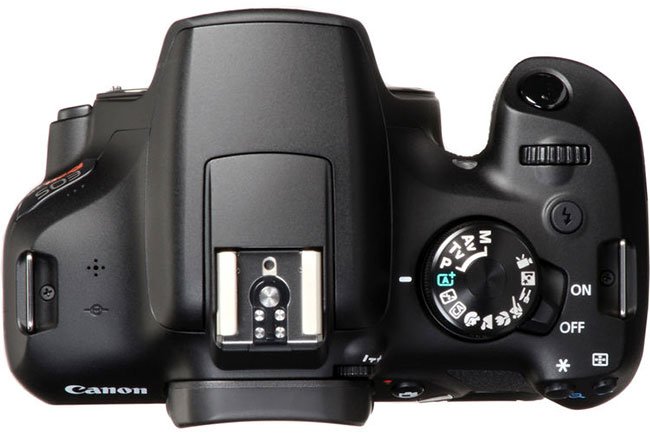
How does the Canon EOS Rebel T6 compare to the Nikon D3400?
The Nikon D3400 is the brand’s flagship beginner DSLR, and a worthy competitor for the . Both cameras also have a similar number of lenses available, pricing, and RAW image shooting. And Nikon and Canon both have long histories as the two most popular DSLR manufacturers on the market. So what do each of these fine cameras do best?
Advantages of the Canon EOS Rebel T6
Wireless Connectivity: The Nikon D3400’s Bluetooth connectivity allows photographers to transfer images to smart devices. But it does not give full remote control of the camera like the Canon Camera Connect app with the Rebel T6.
Auto Exposure Bracketing: AE Bracketing is useful for scenes where the lighting is especially tricky. It’s also great if you don’t have time to take test shots and make adjustments. Using this mode, the user can take a series of images together. And each image has the brightness adjusted to be brighter or darker than normal by a preset amount. All are saved to the memory card so the photographer can select their favorite. The Nikon D3400 does not have this ability.
Advantages of the Nikon D3400
Higher Native ISO: The T6 will struggle if the light levels aren’t optimal as the ISO only reaches 6,400 without digital boosting. The D3400 has more flexibility with its higher native ISO of 25,600.
24 MP of Resolution: This is more of a wash since most photographers don’t really need 24 MP of resolution. And the pixels of the T6 are 33% larger, giving it better noise control in most lighting situations. But given the ISO advantage of the D3400, the extra resolution is nice to have for cropping and printing larger pictures.
Increased Battery Life: The D3400 has more than double the endurance of the T6. 1200 shots per charge can last multiple shoots compared to 500 shots per charge with the T6.
Lighter Weight: At 395 g, the Nikon D3400 is significantly lighter than the Rebel T6 at 485 g.
Nikon’s beginner model has nearly all of what Canon has to offer. But overall, the D3400 is a slightly better camera body to start with. The wireless connectivity of the T6 might be mandatory for some users. But the longer stamina and low light performance of the D3400 are hard to beat.

How does the Canon EOS Rebel T6 compare to the Canon EOS Rebel T6i?
The T6 is very similar to the T6i but has been trimmed down and lightened to make it more economical. As a result, the battery life is noticeably better. The T6 can create 500 shots per charge while the T6i maxes out at 440 shots. The T6 is also lighter at 485 g vs 555 g. With a price of from $549.00, the T6 is also cheaper than the T6i at from $749.00.
The T6 has 18 megapixels of resolution compared to 24 MP with the T6i. While this may seem like a clear advantage of the T6i, the pixel size of the T6 is also 33% larger. This means each individual pixel collects more light. Noise control is improved as a result. Therefore, the T6 has a slight edge in noise control in standard lighting situations. But in low-light settings, the higher native ISO of the T6i (12,800 vs 6,400) make it the better choice.
The T6 does have a number of disadvantages compared to the T6i. For starters, it has no touchscreen. When using Live View mode, the touchscreen of the T6i lets the user select AF points with their fingers. The T6i also has UHS-1 compatibility, letting it use faster recording memory cards. Given the continuous shooting speed of the T6i is 5 fps (compared to 3 fps for the T6), extra speed is handy to have. The faster DIGIC 6 processor of the T6i is better optimized for low light performance for both photography and video. The T6i has 19 AF points, 10 more than the T6. This gives the T6i significant flexibility in creative composition styles.
The two cameras share a similar skeleton and basic features. But the T6i brings moderately increased speed and flexibility with its touchscreen functionality. However, the price of the T6 is extremely hard to ignore, making either camera a fine choice.
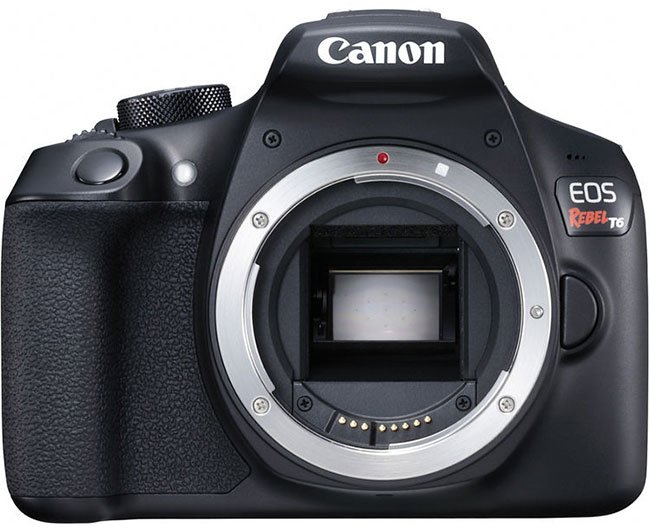
Who should buy the Canon EOS Rebel T6?
The Rebel T6 has the features, design, and price tag of a beginner DSLR camera. It’s meant for photographers upgrading from a point-and-shoot or smartphone camera. It does not have a huge number of features, which may seem boring at first. But the straightforward design of the T6 facilitates its ease of use and keeps the price reasonable. And despite not having lots of fun tools, it can take fine pictures.
Lens selection often impacts image quality as much as the camera body. So as a budget interchangeable lens camera, the Rebel T6 gives a beginner ample room to grow. And when they decide to upgrade to another Canon body, the lenses will remain useful. Best of all, the T6 is usable by photographers interested in most types of photography. The light sensitivity is not very high, however, which limits its capacity in low light situations.
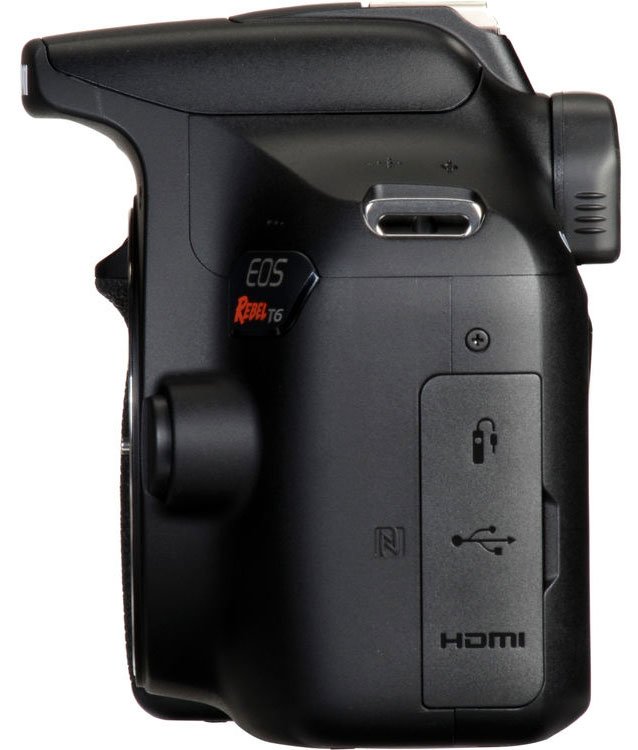
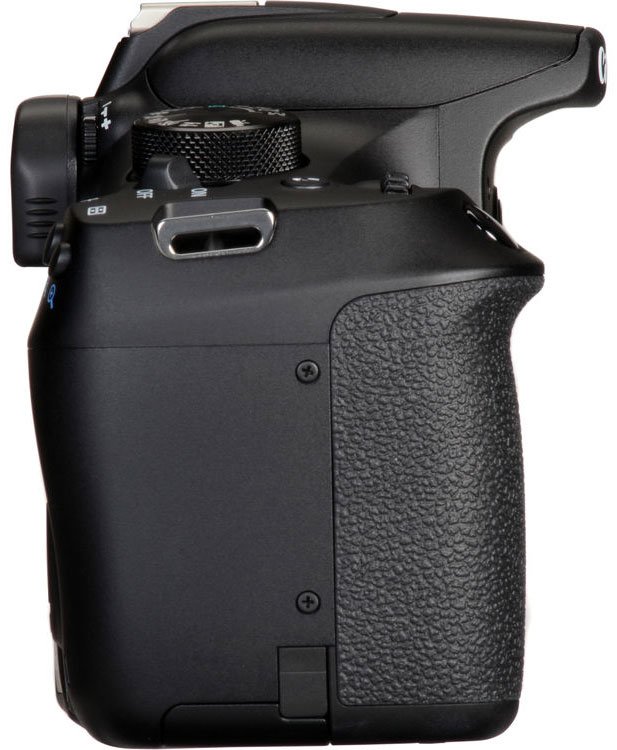
Sample Images
Conclusion
The Canon EOS Rebel T6 has a very basic palette as far as features are concerned. No 4K video, built-in image stabilization, or advanced electronic viewfinder options. But for photographers looking to start with a DSLR camera, the intuitive design of the T6 is hard to beat. The Feature Guide explains exactly what each setting can do. And the major functions are instantly accessed with a basic selection of buttons and dials. While it has the bulky styling typical of DSLRs, it’s not nearly as heavy as more advanced models. Intermediate and advanced users will be annoyed by the lack of customization and advanced features. But it’s one of the best DSLR cameras on the market for the new user. If you’re looking to get great photos right out of the box with minimal fuss and price, the Rebel T6 is a fantastic choice.



















